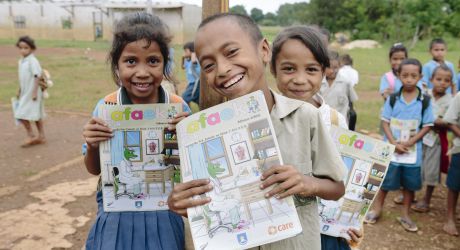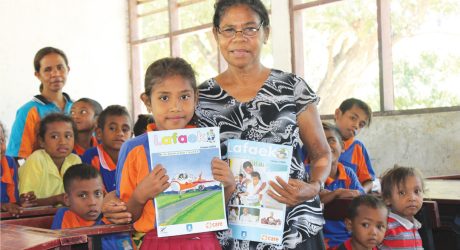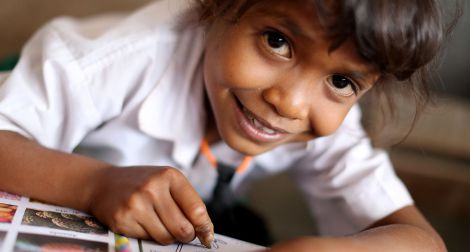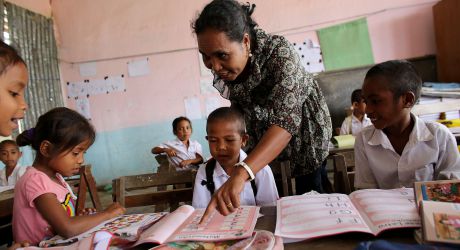Project Background
In Timor-Leste half the population live below the poverty line and, although education is the key to overcoming poverty, 60 per cent of Timor-Leste’s adult population are still unable to read.
Gaining an education in Timor-Leste is a big challenge, particularly as schools are extremely underfunded and poorly resourced. Teaching materials such as text books are in short supply. This means teachers are unable to deliver quality structured lessons and children are not learning at the reasonable level needed to go on to high school or university.
Project Overview
The Lafaek Education project is supporting the education of a new generation of Timorese children. With your support, CARE has been able to create, publish and distribute two editions of the magazine for Grade 3 and 4 students – Lafaek Prima – to more than 80,000 girls and boys. As the only written material in the national language of Tetun and the only publication that reaches every village in the country, Lafaek is a powerful tool that is improving education for both students and their families break free from poverty.
Key Project Outcomes
- 85,276 Grades Three and Four students in 1,370 schools received educational magazine Lafaek Prima
- Content in Lafaek Prima builds on what students learnt in Lafaek Ki’ik in grades 1 and 2
- Children are learning about the different roles women can have in society outside of traditional roles, with strong women and girl characters featuring
- Inclusivity is promoted by introducing characters with disabilities
- Lafaek Prima is developed alongside school and government bodies, ensuring the education magazine is effective, relevant and appropriate as a learning tool.

Project Impacts
1. Improved learning for primary school students in grades three and four
Lafaek Prima is tackling low literacy skills amongst Timor-Leste’s early to mid-primary school students, by providing relevant and engaging reading content distributed to all children at Grades Three and Four. The magazine builds on the literacy promoted in CARE’s early childhood magazine, Lafaek Ki’ik, and supports further development as reading and writing expectations increase.
2. Improved child protection and raising awareness about sensitive issues
The Lafaek magazines began as a child rights magazine, and our project continues to address the issue of child protection through stories and discussions in the magazine. Lafaek Prima helps create awareness about sensitive issues, such as the prevention of sexual harassment and abuse, and physical discipline of children.
3. Worked closely with government to create engaging content
We prepared all the content for Lafaek Prima in close collaboration with teachers, education staff and relevant government departments, ensuring the magazines are suitable and engaging. Each magazine is developed, reviewed and agreed by the Government Ministry of Educations, before being approved by an advisory board, made up of local education bodies, representatives from the New Zealand and Australian foreign departments and CARE.
4. Promoted the empowerment of girls and women
Lafaek Prima contributes towards women’s empowerment through building girls’ leadership and decision-making capabilities. The magazine includes stories and features which show women and men, and girls and boys in non-traditional gender roles. The magazine published articles on history, science and Timorese personalities, highlighting the significant roles of women and the importance of diversity.
Stories feature strong female role models, showing women and girls as leaders and decision-makers, supported by men and boys at school, home, in the community and in public life. As an example, the first edition of Lafaek Prima featured a story about a disabled female character who led her team to win a drawing competition organised at her school. The second edition included the story of a school girl who leads her classmates to build and maintain their school garden.

Case Study: Jacinta learns to read with Lafaek
Jacinta* is a third grade student in Timor-Leste who loves reading the stories in Lafaek Magazine. In second grade, Jacinta received Lafaek Ki’ik magazine, but was unable to read it by herself. Her favourite story in Lafaek Ki’ik was called ‘Asika the Pilot’, about a girl who flies planes.
With the help of her teacher, Lucia Ferreira Cardoso, Jacinta is now able to read Lafaek Prima on her own. Jacinta says she feels very happy because she can
read the stories by herself. She carries the magazines to school to read, and tests her reading skills with her friends in class.
Lucia says the magazines have made a huge difference to Jacinta’s learning comprehension: “At first, I taught Jacinta the letters, and then I taught her syllables and how to spell words with two to three letters,” she explains.
“The result has been very good, Jacinta can now read alone. I feel very happy when I see Jacinta reading.”
*CARE is a child-safe organisation, and the name has been changed.
Project Overview
In Timor-Leste half the population live below the poverty line and, although education is the key to overcoming poverty, 60 per cent of Timor-Leste’s adult population are still unable to read.
Gaining an education in Timor-Leste is a big challenge, particularly as schools are extremely underfunded and poorly resourced. Teaching materials such as text books are in short supply. This means teachers are unable to deliver quality structured lessons and children are not learning at the reasonable level needed to go on to high school or university.
The negative outcomes of being unable to read or write are well documented. Illiteracy is strongly associated with poverty and ill health as people are unable to participate fully in all aspects of society including employment. There are many other downsides to such a high rate of illiteracy, not only for the people themselves, but for the country as a whole. High illiteracy among adults seriously reduces the pool of people from which Timor-Leste can draw on leadership for political, cultural and economic development. As Timor-Leste struggles to grow and develop post-independence, education in Timor-Leste will remain a priority for the success of the country and its people.

Project Objectives
The Lafaek project works in partnership with skilled education practitioners and the Ministry of Education to design and print a teaching and learning magazine for primary school children in grades 3 and 4. This educational magazine will be the only learning resource available to these children in their local language, Tetun. The content and activities encourage children to see learning as fun, while improving their numeracy, literacy and critical thinking skills.
In–line with the school semester, CARE will manage delivery of the Lafaek magazine to every single child enrolled in grades 3 and 4 in every primary school in the country, a difficult logistical task, considering some schools are remote and roads and transport options are poor.
As the only written publication of any kind that reaches every village in the country, this project will be a powerful tool in lifting Timor-Leste and its people out of the cycle of poverty; outcomes to achieve this include:
- 85,000 primary children have improved literacy, numeracy and critical thinking skills.
- Teachers plan and deliver better classes through activities and lesson plans in the magazine.
- The national curriculum is supported by promoting and reinforcing literacy in the classroom and in the home.
- Parents and siblings participate in a child’s learning at home, reinforcing and promoting education at all levels.
- Children develop into self-confident and responsible citizens who aspire to complete their education.
- Women and girls’ participate in leadership and decision-making.

Funding for the project will allow for:
- CARE education specialists and members of the Ministry of Education to design Lafaek in Timor-Leste’s capital, Dili.
- Hiring a writer.
- Two annual printing runs of 85,000 for each edition.
- Twice yearly distribution by car, motorbike, horse and foot to every single school in every village in Timor-Leste.
- Monitoring and evaluation of the immediate impacts resulting from the project and how these impacts are contributing to long term learning outcomes.
How does this project fit into a larger strategy?
CARE Australia currently develops, prints and facilitates the nationwide rollout of three other versions of the Lafaek educational magazines. In the current series, 9,000 teachers receive the ‘Educator’ magazine which provides teachers with useful classroom and teaching information. Every household in remote Timor-leste receives ‘Komunidade’ which provides communities with important public health and social messages and 120,000 children in grades 1 and 2 receive a copy of Lafaek. Extending Lafaek’s reach to grades 3 and 4 will ensure learning is consolidated and more children have access to a quality education.